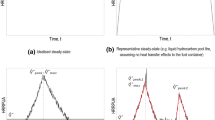From the results of experimental studies of the processes of suppressing the thermal decomposition of the typical forest combustibles (birch leaves, fir needles, asp twigs, and a mixture of these three materials) by water aerosol, the minimum volumes of the fire-extinguishing liquid have been determined (by varying the volume of samples of the forest combustibles from 0.00002 m3 to 0.0003 m3 and the area of their open surface from 0.0001 m2 to 0.018 m2). The dependences of the minimum volume of water on the area of the open surface of the forest combustible have been established. Approximation expressions for these dependences have been obtained. Forecast has been made of the minimum volume of water for suppressing the process of thermal decomposition of forest combustibles in areas from 1 cm2 to 1 km2, as well as of the characteristic quenching times by varying the water concentration per unit time. It has been shown that the amount of water needed for effective suppression of the process of thermal decomposition of forest combustibles is several times less than is customarily assumed.
Similar content being viewed by others
References
A. M. Grishin, Mathematical Simulation of Forest Fires and New Methods of Fighting Them [in Russian], Nauka, Novosibirsk (1992).
E. A. Shchetinskii, Quenching of Forest Fires: Textbook for Forest Firemen [in Russian], 3rd revised and enlarged edn., All-Russia Scientific-Research Institute for Forestry and Forestry Mechanization (VNIILM), Moscow (2002).
G. V. Kuznetsov and N. V. Baranovskii, Forecast of the Occurrence of Forest Fires and of Their Ecological Consequences [in Russian], Izd. SO RAN, Novosibirsk (2009).
N. A. Korshunov and P. M. Matveev, Use of aviation for quenching forest fires. The game is worth the candle, Lesn. Byull., No. 27 (2006).
Yu. F. Zhuravlev, E. P. Mikhal'kova, and A. N. Varyukhin, Hydrodynamical aspects of fighting forest fires with the aid of aviatankers with vertical dropping of liquid, Pozhar. Bezop., No. 3, 132–140 (2014).
I. R. Khasanov, V. S. Gorshkov, and E. A. Moskvilin, Parameters of the process of forest fighting fires with water supply by means of aviation, in: Proc. 4th Int. Conf. "Forest and Steppe Fires: Origination, Propagation, Quenching, and Ecological Consequences," September 25–29, 2001, Irkutsk (2001), pp. 157–158.
N. P. Kopylov, I. R. Khasanov, A. E. Kuznetsov, D. V. Fedotkin, E. A. Moskvilin, P. A. Strizhak, and V. N. Karpov, Parameters of water discharge by aviation means in quenching forest fires, Pozhar. Bezop., No. 2, 49–55 (2015).
O. P. Korobeinichev, A. G. Shmakov, A. A. Chernov, T. A. Bol′shova, V. M. Shvartsberg, K. P. Kutsenogii, and V. I. Makarov, Fire fighting with the aid of aerosols of salt solutions, Fiz. Goreniya Vzryva, 46, No. 1, 20–25 (2010).
O. P. Korobeinichev, A. G. Shmakov, V. M. Shvartsberg, A. A. Chernov, S. A. Yakimov, K. P. Koutsenogii, and V. I. Makarov, Fire suppression by low-volatile chemically active fire suppressants using aerosol technology, Fire Safety J., 51, 102–109 (2012).
V. D. Zakhmatov, Promising recent developments of facilities for quenching forest fires, Pozharovzryvobezopasnost’, 20, No. 2, 47–49 (2011).
R. S. Volkov, G. V. Kuznetsov, and P. A. Strizhak, The influence of initial sizes and velocities of water droplets on transfer characteristics at high-temperature gas flow, Int. J. Heat Mass Transf., 79, 838–845 (2014).
R. S. Volkov, G. V. Kuznetsov, and P. A. Strizhak, Experimental investigation of mixtures and foreign inclusions in water droplets influence on integral characteristics of their evaporation during motion through high-temperature gas area, Int. J. Therm. Sci., 88, 193–200 (2015).
O. V. Vysokomornaya, G. V. Kuznetsov, and P. A. Strizhak, Experimental investigation of atomized water droplet initial parameters influence on evaporation intensity in flaming combustion zone, Fire Safety J., 70, 61–70 (2014).
P. A. Strizhak, Influence of the droplet distribution in a "water jet" on the temperature and concentration of combustion products in its wake, J. Eng. Phys. Thermophys., 86, No. 4, 895–904 (2013).
G. V. Kuznetsov and P. A. Strizhak, Heat and mass transfer in quenching the reaction of thermal decomposition of a forest combustible material with a group of water drops, J. Eng. Phys. Thermophys., 87, No. 3, 608–617 (2014).
O. V. Vysokomornaya, G. V. Kuznetsov, and P. A. Strizhak, Evaporation of water droplets in a high-temperature gaseous medium, J. Eng. Phys. Thermophys., 89, No. 1, 141–151 (2016).
R. S. Volkov, G. V. Kuznetsov, J. C. Legros, and P. A. Strizhak, Experimental investigation of consecutive water droplets falling down through high-temperature gas zone, Int. J. Heat Mass Transf., 95, 184–197 (2016).
Author information
Authors and Affiliations
Corresponding author
Additional information
Translated from Inzhenerno-Fizicheskii Zhurnal, Vol. 90, No. 4, pp. 832–840, July–August, 2017.
Rights and permissions
About this article
Cite this article
Volkov, R.S., Zhdanova, A.O., Kuznetsov, G.V. et al. Determination of the Volume of Water for Suppressing the Thermal Decomposition of Forest Combustibles. J Eng Phys Thermophy 90, 789–796 (2017). https://doi.org/10.1007/s10891-017-1627-5
Received:
Published:
Issue Date:
DOI: https://doi.org/10.1007/s10891-017-1627-5




